Problems
Standard |
No Evidence |
Beginning |
Developing |
Proficient |
Excellent |
Mastering |
E-1. Problems Define problems that can be solved |
No evidence of defining a problem |
You define a problem |
You define a real problem and its criteria and constraints |
You completely, specifically, and accurately define the criteria and constraints of a real problem that can be reasonably solved |
Your work is proficient and your presentation is excellent. |
Your work is excellent and you explain how the problem impacts society |
A Well-Defined Problem
|
A Really Well-Defined Problem
|
Go Above & Beyondby explaining how the problem impacts society.
|
Engineers solve problems by creating new products, systems, or environments.
Before creating something, it is very important to define the problem. Otherwise, you might build something only to find that it does not meet the original goal!
To define your problem, answer each of these questions:
The answers to these three questions are the what, who, and why of your problem.
To define your problem, answer each of these questions:
- What is the problem or need?
- Who has the problem or need?
- Why is it important to solve?
The answers to these three questions are the what, who, and why of your problem.
Your problem statement should incorporate the answers as follows:
[Who] need(s) [what] because [why]
[Who] need(s) [what] because [why]
In design terms, who, what, and why can be defined as:
- Who = the user
- What = the need
- Why = the insight
Once you have determined your problem you need to define the criteria for a successful solution and the constraints of the problem.
Criteria: the qualities that your final solution will have when it is complete
Constraints: the limits of your possible solution (including time, materials, cost, scientific knowledge, risk, and societies expectations)
Constraints: the limits of your possible solution (including time, materials, cost, scientific knowledge, risk, and societies expectations)
Examples
The problem: "People who live in buildings in earthquake zones need less damage to be inflicted on their homes during earthquakes because the damage is dangerous and expensive."
Criteria:
Criteria:
- the solution will survive testing in the shake box
- the solution will be modeled out of materials from The Shop
- the solution will have reasonable proportions to a real building
- we are only modeling the structural elements of the building, not electrical or plumbing
- we only have one week in The Shop to build

